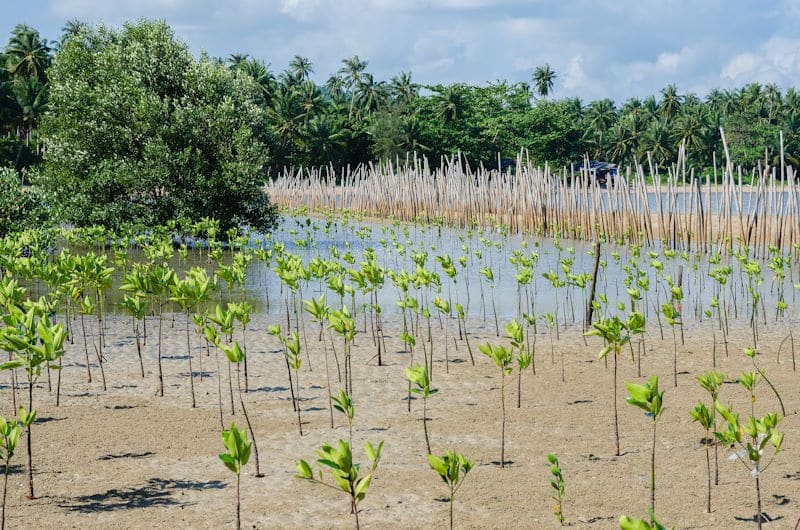
Mangroves, often celebrated for their unique ecosystems and coastal protection capabilities, also play a significant role in carbon sequestration and climate change mitigation. At Save Mangroves Nursery, we are dedicated to highlighting the critical environmental functions of mangroves.
Here’s an in-depth look at how these remarkable trees contribute to carbon sequestration and help combat climate change.
1. Exceptional Carbon Sequestration Capacity
Mangroves are among the most carbon-rich forests in the world. They sequester carbon dioxide (CO2) from the atmosphere through photosynthesis, storing it in their biomass (trunks, branches, leaves, and roots) and in the soil.
What sets mangroves apart is their ability to store large amounts of carbon in waterlogged, anaerobic soils, where it can remain for centuries or even millennia.
According to the National Oceanic and Atmospheric Administration, mangrove forests can capture and store carbon for thousands of years.
2. Carbon Storage in Biomass
The dense biomass of mangroves, including their extensive root systems, serves as a significant carbon sink. Unlike terrestrial forests, mangroves accumulate and store carbon both above and below ground. This dual storage capability makes them incredibly efficient at sequestering carbon.
Studies have shown that mangroves can store up to four times more carbon per unit area than terrestrial forests.
3. Long-Term Carbon Storage in Soils
Mangrove soils are rich in organic matter, which includes dead plant material and other organic debris. These soils are often waterlogged and low in oxygen, conditions that slow down the decomposition of organic matter.
As a result, carbon stored in mangrove soils is less likely to be released back into the atmosphere, ensuring long-term carbon sequestration.
4. Blue Carbon Ecosystems
Mangroves are part of a group of coastal and marine ecosystems known as blue carbon ecosystems, which also include salt marshes and seagrasses. These ecosystems are highly effective at capturing and storing carbon, making them essential in the fight against climate change.
Mangroves, in particular, are recognized for their superior carbon sequestration abilities and their role in maintaining the health and productivity of coastal environments.
Here’s a video on how mangroves help the oceans of the world:
5. Climate Change Mitigation
By sequestering significant amounts of carbon, mangroves help to mitigate the impacts of climate change. Reducing atmospheric CO2 levels is crucial for slowing global warming and its associated effects, such as rising sea levels, extreme weather events, and shifts in ecosystems.
Mangrove conservation and restoration efforts contribute directly to reducing the concentration of greenhouse gases in the atmosphere.
6. Coastal Protection and Resilience
In addition to their carbon sequestration benefits, mangroves provide critical protection to coastal communities from the impacts of climate change. Their root systems stabilize shorelines, reduce erosion, and buffer against storm surges and flooding.
By preserving and restoring mangroves, we enhance the resilience of coastal areas to climate-related threats, safeguarding both human populations and biodiversity.
7. Biodiversity and Ecosystem Services
Mangroves support rich biodiversity, providing habitats for a wide range of species. This biodiversity contributes to the overall health and resilience of coastal ecosystems, which are essential for maintaining ecological balance and supporting livelihoods.
Healthy mangrove ecosystems offer numerous ecosystem services, including water filtration, nutrient cycling, and fisheries support, all of which are vital for sustainable development.
8. Socio-Economic Benefits
The conservation and restoration of mangroves can also yield significant socio-economic benefits. Mangrove forests support fisheries, provide timber and non-timber products, and attract tourism. These activities generate income and employment opportunities for local communities, fostering sustainable development and enhancing quality of life.
Moreover, healthy mangroves contribute to food security and poverty alleviation.
9. Global Conservation Efforts
Recognizing the importance of mangroves in carbon sequestration and climate change mitigation, global conservation efforts are increasingly focused on protecting and restoring these vital ecosystems. Initiatives such as the Blue Carbon Initiative and various national and international policies aim to promote mangrove conservation as a key strategy in addressing climate change.
Mangroves are invaluable allies in the fight against climate change, offering exceptional carbon sequestration capabilities and a host of other environmental and socio-economic benefits. At Save Mangroves Nursery, we are committed to raising awareness about the importance of mangroves and supporting their conservation and restoration.
How Do I Choose My Very First Plant?
So you have learned about the incredible benefits of adding mangrove plants to your tank, but you still don’t know which exact plant to add to your specific tank size?
Don’t worry, because we’ve created an easy Step-by-Step guide to help you with your selection process.
Click the button below to find out which plant is perfect for your aquarium.

 Cart is empty
Cart is empty 
